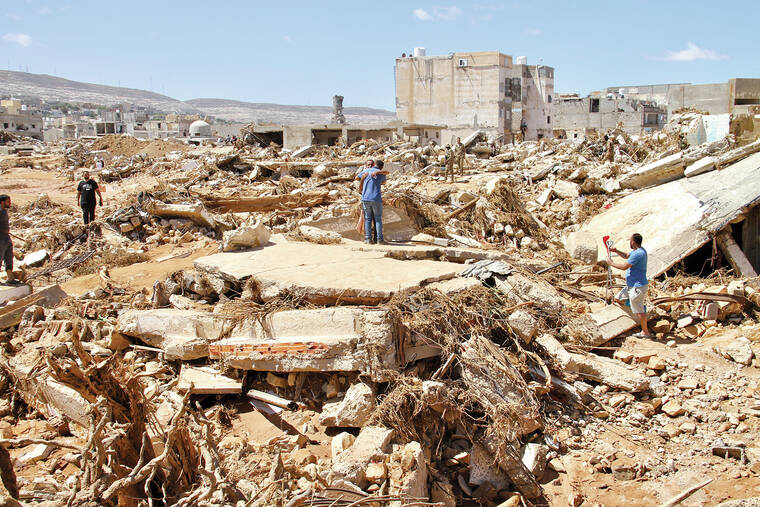Libya was mired in chaos and corruption. For years, warnings the Derna dams may burst went unheeded
CAIRO — The warnings were clear but went unheeded.
Experts had long said that floods posed a significant danger to two dams meant to protect nearly 90,000 people in the northeast of Libya. They repeatedly called for immediate maintenance to the two structures, located just uphill from the coastal city of Derna. But successive governments in the chaos-stricken North African nation did not react.
“In the event of a big flood, the consequences will be disastrous for the residents of the valley and the city,” Abdelwanees Ashoor, a professor of civil engineering, wrote in a study published last year in the Sabha University Journal of Pure and Applied Sciences.
The warnings came true in the early hours of Sept. 11, when residents of Derna woke up to loud explosions before floodwaters pounded the Mediterranean city. They found that two dams had broken, unleashing a wall of water two stories high that wreaked destruction and swept entire neighborhoods out to sea.
The deluge proved deadly for thousands in just seconds, uprooting apartment buildings and washing away roads and bridges.
The death toll has been varied, with different government officials and aid agencies giving different tallies. Libya’s Red Crescent has said at least 11,300 people have been killed and an additional 10,000 are missing. After earlier reporting that same death toll, U.N. Office for the Coordination of Humanitarian Affairs is now citing far lower numbers, with about 4,000 people killed and 9,000 missing,
East Libya’s Health Minister Othman Abduljaleel said at least 3,283 bodies were buried as of Sunday night. He didn’t say how many bodies had been retrieved in total.
Neglect and corruption are rife in Libya, a country of about 7 million people that lies on a wealth of proven oil and natural gas reserves. As of 2022, the country ranked 171 out of 180 on the transparency index compiled by Transparency International.
The North African nation has been in chaos since 2011, when an Arab Spring uprising, backed by NATO, ousted longtime dictator Moammar Gadhafi, who was later killed.
The country has since divided between rival administrations: one in the west backed by an array of lawless armed groups and militias, and the second in the east allied with the self-styled Libyan National Army, which is commanded by powerful Gen. Khalifa Hifter.
The dams, Abu Mansour and Derna, were built by a Yugoslav construction company in the 1970s above Wadi Derna, which divides the city. Abu Mansour, 14 kilometers (8.6 miles) from the city, was 74 meters (243 feet) high and could hold up to 22.5 million cubic meters of water. The Derna dam, also known as Belad, is much closer to the city and could hold 1.5 million cubic meters of water.
The dams, built from clay, rocks and earth, were meant to protect the city from flash floods, which are not uncommon in the area. Water collected behind the dams was used to irrigate crops downstream.
The dams suffered major damage in a strong storm that hit the region in 1986, and more than a decade later a study commissioned by the Libyan government revealed cracks and fissures in their structures, Libya’s general prosecutor, al-Sediq al-Sour, said late Friday.
A report by a state-run audit agency in 2021 said the two dams hadn’t been maintained despite the allocation of more than $2 million for that purpose in 2012 and 2013. No work was done in the area, and the audit agency blamed the Ministry of Works and Natural Resources for failing to cancel the contract and give it to a company that would do the work.
A Turkish firm was contracted in 2007 to carry out maintenance on the two dams and build another dam in between. The firm, Arsel Construction Company Ltd., says on its website that it completed its work in November 2012.
Arsel didn’t respond to an email seeking further comment on the two dams. No third dam appeared to have ever been built, recent satellite photos show.


